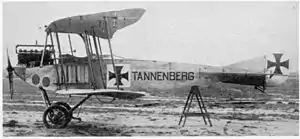DFW B.I
The DFW B.I (factory designation MD 14), was one of the earliest German aircraft to see service during World War I, and one of the numerous "B-class" unarmed, two-seat observation biplanes of the German military in 1914, but with a distinctive appearance that differentiated it from contemporaries.[1] Though a biplane, its crescent-planform three-bay wings were inspired by that of the earlier Rumpler Taube monoplane, and led to the DFW aircraft being named the Fliegende Banane ("Flying Banana") by its pilots.
| B.I and B.II | |
|---|---|
 | |
| DFW B.I Tannenberg, one of the few "named" DFW aircraft | |
| Role | Reconnaissance / Army co-operation |
| Manufacturer | Deutsche Flugzeugwerke |
| Designer | Walter Oelerich |
| Introduction | 1914 |
| Retired | 1915 |
| Primary user | Luftstreitkräfte |

Crashed DFW B.I "Weddingen" showing shape of wings
The B.II was similar but was built as a trainer. Some were fitted with the more powerful Mercedes D.II engine.
Specifications (DFW B.I)
Data from German Aircraft of the first World War[2]
General characteristics
- Crew: 2
- Length: 8.4 m (27 ft 7 in)
- Wingspan: 14 m (45 ft 11 in)
- Height: 3 m (9 ft 10 in)
- Wing area: 40 m2 (430 sq ft)
- Empty weight: 650 kg (1,433 lb)
- Gross weight: 1,015 kg (2,238 lb)
- Powerplant: 1 × Mercedes D.I 6-cyl. water-cooled in-line piston engine, 75 kW (100 hp)
Performance
- Maximum speed: 120 km/h (75 mph, 65 kn)
- Range: 600 km (370 mi, 320 nmi)
- Service ceiling: 3,000 m (9,800 ft)
References
- Wagner, Ray and Nowarra, Heinz. German Combat Planes: A Comprehensive Survey and History of the Development of German Military Aircraft from 1914 to 1945. New York: Doubleday, 1971.
- Gray, Peter; Owen Thetford (1970). German Aircraft of the first World War (2nd ed.). London: Putnam & Company Ltd.
External links
| Wikimedia Commons has media related to DFW B.I. |
This article is issued from Wikipedia. The text is licensed under Creative Commons - Attribution - Sharealike. Additional terms may apply for the media files.